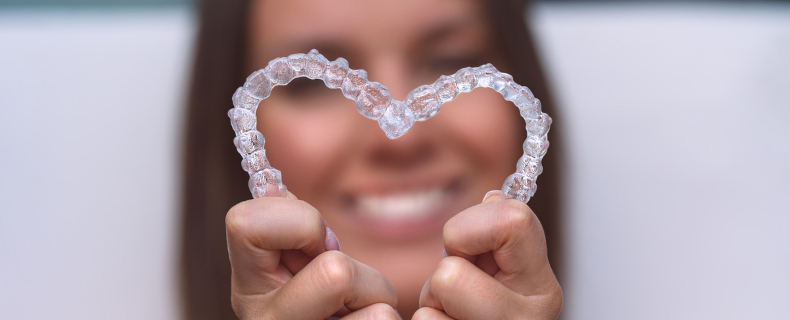Okemos, Lansing, East Lansing MI
Invisalign is an orthodontic procedure, designed, like all orthodontic procedures, to bring the teeth into proper alignment. Invisalign can provide all the oral health advantages of aligned teeth, and it can potentially correct speech difficulties. It can also give a major boost to appearance, as straight teeth are considered an important component of having a beautiful smile.
Invisalign is essentially an alternative to traditional wire braces and was, in fact, designed for this purpose in 1997 by two Stanford business school students. One of them was undergoing adult orthodontic treatment and wondered if there was a way to accomplish the same outcomes as braces without the various inconveniences that braces entail. The idea was a good one: in 2000, the FDA approved the procedure, and since then, millions of people have used Invisalign for a healthy bite and straight teeth.
How does Invisalign work, and what are the steps to take?
Consultation and fabrication
Invisalign first begins with a dental consultation. The dentist will have undergone training to become a certified Invisalign provider. The dentist will then assess whether the prospective patient is a good candidate for the procedure. Mainly, this involves checking:
Age
Since children do not have all their adult teeth, those who have not yet reached a certain age are not usually considered the best candidates for Invisalign.
Oral health
Patients who have gum disease will need to treat that before the process begins. Also, there are some people with naturally small teeth, and others with worn or eroded teeth, for whom the treatment may not be the best choice. Those with severe overbite that would usually require surgery are also not often the best candidates, nor are people with bridges, partial dentures, and implants. People who suffer from TMJ may find that the condition worsens while Invisalign is being applied; and finally, smokers may still benefit from the procedure, but smoking might discolor the appliances.
Commitment
One of the main advantages of Invisalign is that the corrective appliances are removable for eating and oral hygiene, etc. However, they should be worn between 20 and 22 hours per day (even while sleeping) and need to be changed frequently, often every 2-8 weeks. It is important to wear these aligners for that amount of time during the day, and to keep appointments for new aligners, because each new aligner assumes a certain level of progress to fit properly. For those who may not be able to handle these requirements, Invisalign may not be the best procedure for them.
If it has been determined that the patient is a good candidate, the dentist will take X-rays and impressions of the teeth and create a detailed plan for getting them into alignment. He or she will then send these to the Invisalign company that will use computers to create a 3D-model of the teeth and doublecheck with the dentist. They will then fabricate a number of plastic, clear aligners to send to the dentist. This process can take up to a month.
Wearing the aligners
The patient then goes back to the dentist, is given the first aligner, and starts wearing them.
The patient is expected to wear these aligners pretty much all the time, up to 22 hours a day. Some mild discomfort should be expected, especially at first, but this is almost always very well-tolerated. These are worn for a predetermined time (again, usually between 2 and 8 weeks), then a return trip to the dentist is in order for a quick evaluation (about five minutes) to get the next aligner. In as little as six months, the treatment is concluded (though this varies from person to person).
Why Invisalign?
There are a number of advantages to wearing Invisalign over braces. One of the most obvious is that they are discreet (the “Invisi-” part of “Invisalign”), so for those who find braces unsightly, this is an ideal solution.
Moreover, the aligners are smooth, with no brackets or wires to feel rough or to catch the lip or gums. Nor are there regular visits to have the braces tightened, which can be uncomfortable.
Probably the main advantage, however, is that the aligners can be removed. This means that brushing is much easier, with no added risk of cavities that often comes with braces. Furthermore, because they are removable, there are no restrictions on eating like with braces.
Tenaglia Smiles has been serving the dental and orthodontic needs of the Okemos area for over 20 years. Dr. Christine Tenaglia can provide much more information about the procedure and whether a patient is a good candidate for it. To make an appointment, call (517) 940-8684 or contact us online.

